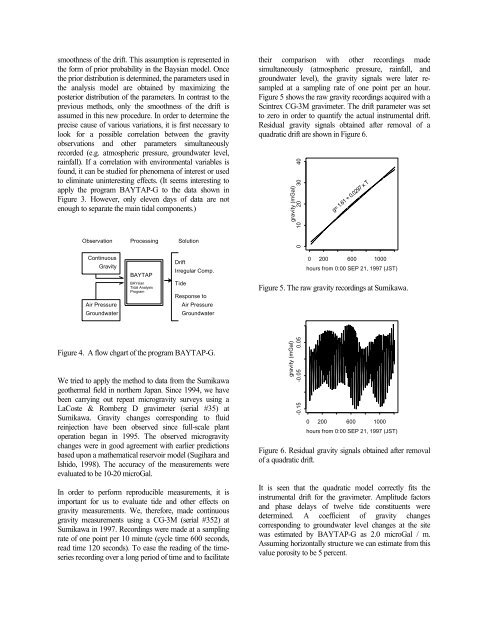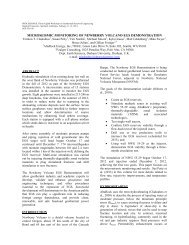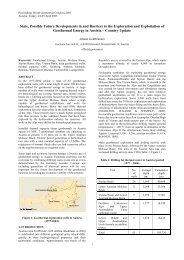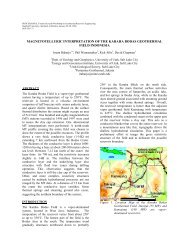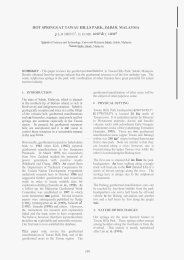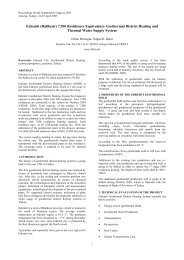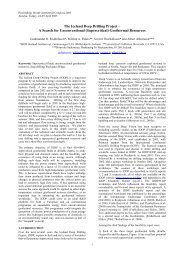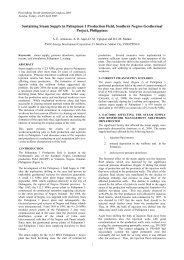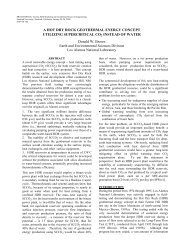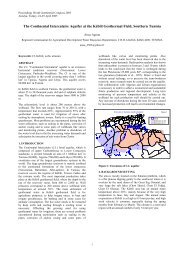CONTINUOUS GRAVITY MEASUREMENTS FOR RESERVOIR ...
CONTINUOUS GRAVITY MEASUREMENTS FOR RESERVOIR ...
CONTINUOUS GRAVITY MEASUREMENTS FOR RESERVOIR ...
You also want an ePaper? Increase the reach of your titles
YUMPU automatically turns print PDFs into web optimized ePapers that Google loves.
smoothness of the drift. This assumption is represented in<br />
the form of prior probability in the Baysian model. Once<br />
the prior distribution is determined, the parameters used in<br />
the analysis model are obtained by maximizing the<br />
posterior distribution of the parameters. In contrast to the<br />
previous methods, only the smoothness of the drift is<br />
assumed in this new procedure. In order to determine the<br />
precise cause of various variations, it is first necessary to<br />
look for a possible correlation between the gravity<br />
observations and other parameters simultaneously<br />
recorded (e.g. atmospheric pressure, groundwater level,<br />
rainfall). If a correlation with environmental variables is<br />
found, it can be studied for phenomena of interest or used<br />
to eliminate uninteresting effects. (It seems interesting to<br />
apply the program BAYTAP-G to the data shown in<br />
Figure 3. However, only eleven days of data are not<br />
enough to separate the main tidal components.)<br />
Observation Processing Solution<br />
their comparison with other recordings made<br />
simultaneously (atmospheric pressure, rainfall, and<br />
groundwater level), the gravity signals were later resampled<br />
at a sampling rate of one point per an hour.<br />
Figure 5 shows the raw gravity recordings acquired with a<br />
Scintrex CG-3M gravimeter. The drift parameter was set<br />
to zero in order to quantify the actual instrumental drift.<br />
Residual gravity signals obtained after removal of a<br />
quadratic drift are shown in Figure 6.<br />
gravity (mGal)<br />
0 10 20 30 40<br />
g= 1.61 + 0.0297 x T<br />
Continuous<br />
Gravity<br />
Air Pressure<br />
Groundwater<br />
BAYTAP<br />
BAYsian<br />
Tidal Analysis<br />
Program<br />
Drift<br />
Irregular Comp.<br />
Tide<br />
Response to<br />
Air Pressure<br />
Groundwater<br />
0 200 600 1000<br />
hours from 0:00 SEP 21, 1997 (JST)<br />
Figure 5. The raw gravity recordings at Sumikawa.<br />
Figure 4. A flow chgart of the program BAYTAP-G.<br />
We tried to apply the method to data from the Sumikawa<br />
geothermal field in northern Japan. Since 1994, we have<br />
been carrying out repeat microgravity surveys using a<br />
LaCoste & Romberg D gravimeter (serial #35) at<br />
Sumikawa. Gravity changes corresponding to fluid<br />
reinjection have been observed since full-scale plant<br />
operation began in 1995. The observed microgravity<br />
changes were in good agreement with earlier predictions<br />
based upon a mathematical reservoir model (Sugihara and<br />
Ishido, 1998). The accuracy of the measurements were<br />
evaluated to be 10-20 microGal.<br />
In order to perform reproducible measurements, it is<br />
important for us to evaluate tide and other effects on<br />
gravity measurements. We, therefore, made continuous<br />
gravity measurements using a CG-3M (serial #352) at<br />
Sumikawa in 1997. Recordings were made at a sampling<br />
rate of one point per 10 minute (cycle time 600 seconds,<br />
read time 120 seconds). To ease the reading of the timeseries<br />
recording over a long period of time and to facilitate<br />
gravity (mGal)<br />
-0.15 -0.05 0.05<br />
0 200 600 1000<br />
hours from 0:00 SEP 21, 1997 (JST)<br />
Figure 6. Residual gravity signals obtained after removal<br />
of a quadratic drift.<br />
It is seen that the quadratic model correctly fits the<br />
instrumental drift for the gravimeter. Amplitude factors<br />
and phase delays of twelve tide constituents were<br />
determined. A coefficient of gravity changes<br />
corresponding to groundwater level changes at the site<br />
was estimated by BAYTAP-G as 2.0 microGal / m.<br />
Assuming horizontally structure we can estimate from this<br />
value porosity to be 5 percent.


